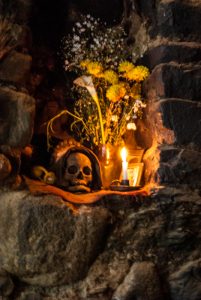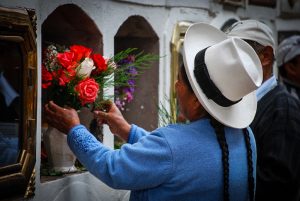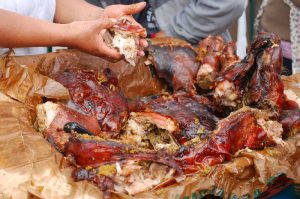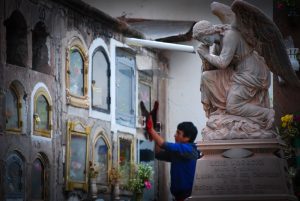The Day of the Living and the Dead Absorbs Cuzco

After today’s fit of pumpkins, costumes, and Creole song fades into tomorrow’s dawn, Cuzqueños will begin celebrating one of the most important feasts in their calendar year. This is the feast called in Spanish Todos Santos, All Saints, or simply El Día de los Muertos y los Vivos, the Day of the Dead and the Living.
The juggernaut of Mexican culture has popularized the Day of the Dead and skeleton figures through much of the English-speaking world. There is no doubt it is related to Peru’s celebrations, but you will not see all the skeletons nor marigolds in Peru.
Mexico, with its roots deep into Spain and its Aztec soil, has a distinct culture around death. Among the country’s many popular saints, one even finds a Saint Death. Not surprisingly, she appears as a skeleton and carries elements of other holy female figures and the grim reaper But, as Andrew Chesnut, the author of a book published by Oxford University Press on St. Death (Devoted to Death: Santa Muerte, the Skeleton Saint) points out, the Andes hold a very different culture of death. They are alone in Latin America in not having a skeleton saint.

Nevertheless, the departed are very important to the living in Cuzco and the rest of Peru and Bolivia. There are popular Saints that include elements of bodies, such as El Niño Compadrito in Cuzco. He is known for incorporating portions of a skeleton. Intriguingly, his image is not that of death, but of ongoing relations between people who are dead and people who still live.
Hence the duality of a feast emphasizing the living and the dead.

Many homes in Cuzco keep a skull of one of their departed ancestors; they feed it regularly and incorporate it into their household.
This is not, however, some Anglo vision of a continuity of family relations–much as they are today–into a world beyond life. Rather, it is a recognition that, though radically changed by death, there is still a relationship between the living and the dead. Generations are not marked only by continuity of family and such in Cuzco, but by discontinuity following Andean traditions.
Children were often called auca, enemies, as strangers and even different kinds of beings brought into the family. They had to be socialized by feasting and clothing in order to integrate into the family. After death, despite the radical change made by death, people still integrate the different beings that result (bones, skulls, and remains in a coffin in a cemetery niche) into society through feasting.

They bring them food, give them drink, and converse with them while the family drinks, eats, and converses too. They even contract musicians to play the favorite music of the dead, which is often locally significant music, and people even dance.
An important consequence of this idea about generations and death is that people are partible, they are combinations of different parts. Babies come into the world and are nourished and dressed, as well as feted to become full members of a family and community, with friends, lovers, and compadres.
Similarly, when the various souls of the living depart (since people are considered to have multiple almas, souls) and only bones remain, those bones are still considered to be part of the whole and contain life. They also must be socialized and kept part of society through feasting and engagement so peace, reciprocity, and solidarity can reign.
Just an example of the separability of people, the Huarochiri stories tell of Paria Caca, a great mountain (and God) near Lima. They say he was born as five eggs. Five in One. The point seems to be an emphasis on the principle of unity in the Quechua suffix -ntin, as in Tawantinsuyo, the unity of four parts or the Inca Empire. It means the active coming together to make something larger and grander.

Tomorrow and Saturday people will be working that -ntin. They will go as families to cemeteries to clean graves and to eat, sing, laugh, and tell stories. They make a whole of themselves that includes their decaying family members. The living and the dead join in a celebration of togetherness.
As fits any celebration Todos Santos is filled with rich symbolism, from bread babies–not unlike the Mexican “pan de muertos” (bread of the dead), this sweet bread formed like babies in their carrying cloth, their quepirina, and horses with ladders.
The babies are swaddled and bound in cloth, as an image of -ntin, the taking of strangers–in this case babies of bread–and making them into members of a group. The horses and ladders speak to outside worlds and travel between them. But they still come together with the clothed babies into making a solidary group.
People can obtain small portions of food modeled in miniature to leave on the grave, if the do not wish to leave the real thing. Miniatures have a long history in the Andes. LIke the babies, they have the potential to grow and become large, to emerge into a living world.
And so on. The whole feast is rich with symbolism and culture. And with activity, not just that of family. Boys come to help clean graves for a small payment, and old people (abuelos–grandparents) sit around waiting to be asked to pray for the dead. They do so, for a price, in Quechua with Latin thrown in, recognizing the power of Quechua in colonial and contemporary Catholicism, as well as the Church Latin.

The prayers while officially Catholic, not infrequently carry some reference to ancient prayers from long before the Spanish came. As a result, let us end this recognition of Todos Santos with a prayer captured in the Huarochiri manuscript to the ancestral figure, a creator, called Cuni Raya Viracocha. He is a very widespread figure in the Andes, who may be related to the waters of the earth, including Lake Titicaca, or the Thunder and lightning in the sky.
Viracocha is long gone back into the earth, and yet he lives in every rainstorm. Salomon and Urioste translate this prayer as follows.
Cuni Raya Vira Cocha,
You who animate mankind,
Who charge the world with being.
All things are yours!
Yours the fields and yours the people.
Help me remember how,
Help me work it out,
Cuni Raya Vira Cocha!




